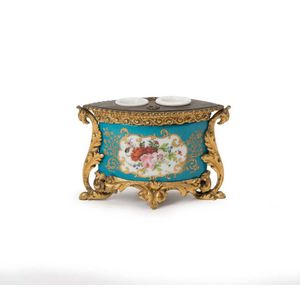Derby porcelain bough pot with spring flowers
You must be a subscriber, and be logged in to view price and dealer details.
Subscribe Now to view actual auction price for this item
When you subscribe, you have the option of setting the currency in which to display prices to $Au, $US, $NZ or Stg.
- Bough Pot - A bough pot is a vessel for holding stems of flowers and branches to decorate an interior, especially a fireplace during summer. They are typically ceramic, often semicircular with a flat back and have a body to hold water. The top has a number of small openings to hold the stems. Often the top lifts off.
The term "bough pot" was common in use in Europe during the 18th and 19th centuries. During the European summer when the fireplace was not in use the fireplace was decorated with floral arrangements. These arrangements consisted of vessels and pots, The term "bough pot" was a colloquial term and came to mean the pots that were used for decorating the fireplace.
The tulipiere and flower brick are types of bough pots that allow larger numbers of flowers. - Cartouche - An ornamental panel in the form of of a shield, oval or rectangular scroll with curling edges. It may be carved into the back of a chair or the top of a sideboard, or present on a piece of silver or jewellery, and contain the initials of the original owner, heraldic symbols, or some other inscription, such as the details of a presentation.
In ceramics the term defines the central area of a vase or similar with a decorative border in one of the shapes above, into which a decorative scene or figures have been painted. - Gilding - Gilding is a method of ornamentation whereby a thin sheet of gold metal is applied to items made of wood, leather, ceramics, glass and silver for decorative purposes.
For furniture including mirrors, the sheet of gold is usually applied over a coating of gesso. Gesso is a mixture of plaster of Paris and gypsum mixed with water and then applied to the carved wooden frames of mirrors and picture frames as a base for applying the gold leaf. After numerous coats of gesso have been applied, allowed to dry and then sanded a coat of "bole", a usually red coloured mixture of clay and glue is brushed on and allowed to dry, after which the gold leaf is applied. Over time parts of the gilding will rub off so the base colour can be seen. In water gilding, this was generally a blue colour, while in oil gilding, the under layer was often yellow. In Victorian times, gilders frequently used red as a pigment beneath the gold leaf.
Metal was often gilded by a process known as fire gilding. Gold mixed with mercury was applied and heated, causing the mercury to evaporate, the long-term effect of which was to kill or disable the craftsman or woman from mercury poisoning. The pursuit of beauty has claimed many victims, not the least of which were the artists who made those pieces so highly sought after today. - Circa - A Latin term meaning 'about', often used in the antique trade to give an approximate date for the piece, usually considered to be five years on either side of the circa year. Thus, circa 1900 means the piece was made about 1900, probably between 1895 and 1905. The expression is sometimes abbreviated to c.1900.
This item has been included into following indexes:
Visually similar items

A Sevres style gilt metal mounted bleu celeste navette shaped ink well, 19th century, 8 cm high

A Dutch silver miniature spice cabinet.

Chinese canister in silver gilt mesh with applied enamel and beaded cover, the knop with a fluted turned Lip 20th century, the six lobed, circular shape has a flowering branch and song birds on each section, 16 cm high 10 cm diameter

A rare Royal Doulton Huntley & Palmers nursery rhymes biscuit casket 'Old Mother Hubbard' - in the shape of a bombe commode. Date mark c.1906. Length 190, height 13 cm
